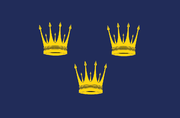
Flag of Munster
Encyclopedia
The flag of Munster consists of three gold crowns on a blue field. The crowns were the arms of Ireland before being superseded by the golden harp in the 16th century. The meaning of the crowns on the flag is not certain, but one possibility is that they may represent three of the medieval English lordships in Munster; the O’Briens (Thormond), the Butlers (Osmond) and the Fitzgeralds (Desmond).

Significantly, from the point of view of finding an explanation for the origin of the arms of Munster, a crown of the type now known as antique Irish, delicately crafted in burnished metal and resting on a blue enamel surface, forms an integral element of a thirteenth century crozier head found near Cormac's Chapel on the Rock of Cashel
, County Tipperary
. This unique artifact of Gaelic Ireland can be viewed in the National Museum of Ireland
, Kildare Street, Dublin.
Cashel
, was from early Christian times through to the fifteenth century the seat of the Kings of Munster
, many of whom exercised spiritual as well as temporal power over the southern province. In the case of the "king-bishops" of Cashel, the placing of the antique crown on their crozier, as instanced above, can only be interpreted as a symbolic assertion of their right to the political sovereignty of Munster.
The three crowns may represent Thomond
(Tuamhain, North Munster), Desmond (Deasumhain, South Munster), and Ormond (Urumhain, East Munster). As to the tincture of the Munster shield, in Gaelic mythology and literature the sovereignty of Munster was personified in Mór Muman
– a beautiful lady dressed in deep blue robes.

Origin of the Flag
The arms shown on the flag are on record as appertaining to Munster as early as the 16th century. The motif, namely the antique Irish crown which inspired them, is without question considerably older.Significantly, from the point of view of finding an explanation for the origin of the arms of Munster, a crown of the type now known as antique Irish, delicately crafted in burnished metal and resting on a blue enamel surface, forms an integral element of a thirteenth century crozier head found near Cormac's Chapel on the Rock of Cashel
Rock of Cashel
The Rock of Cashel , also known as Cashel of the Kings and St. Patrick's Rock, is a historic site in Ireland's province of Munster, located at Cashel, South Tipperary.-History:...
, County Tipperary
County Tipperary
County Tipperary is a county of Ireland. It is located in the province of Munster and is named after the town of Tipperary. The area of the county does not have a single local authority; local government is split between two authorities. In North Tipperary, part of the Mid-West Region, local...
. This unique artifact of Gaelic Ireland can be viewed in the National Museum of Ireland
National Museum of Ireland
The National Museum of Ireland is the national museum in Ireland. It has three branches in Dublin and one in County Mayo, with a strong emphasis on Irish art, culture and natural history.-Archaeology:...
, Kildare Street, Dublin.
Cashel
Cashel, County Tipperary
Cashel is a town in South Tipperary in Ireland. Its population was 2936 at the 2006 census. The town gives its name to the ecclesiastical province of Cashel. Additionally, the cathedra of the Roman Catholic Archdiocese of Cashel and Emly was originally in the town prior to the English Reformation....
, was from early Christian times through to the fifteenth century the seat of the Kings of Munster
Kings of Munster
The name Munster is derived from the Gaelic God, Muman. The province of Munster was once divided into six regions: Tuadh Mhuman , Des Mhuman , Aur/Ur Mumhan , Iar mumhan or Iarmuman , Ernaibh Muman , and Deisi Muman...
, many of whom exercised spiritual as well as temporal power over the southern province. In the case of the "king-bishops" of Cashel, the placing of the antique crown on their crozier, as instanced above, can only be interpreted as a symbolic assertion of their right to the political sovereignty of Munster.
The three crowns may represent Thomond
Thomond
Thomond The region of Ireland associated with the name Thomond is County Clare, County Limerick and north County Tipperary; effectively most of north Munster. The name is used by a variety of establishments and organisations located in , or associated with the region...
(Tuamhain, North Munster), Desmond (Deasumhain, South Munster), and Ormond (Urumhain, East Munster). As to the tincture of the Munster shield, in Gaelic mythology and literature the sovereignty of Munster was personified in Mór Muman
Mór Muman
Mór Muman , also written Mór Mumhan or Mór Mumain, is stated to have been a daughter of Áed Bennán, sometime King of Munster, but may in fact represent a euhemerised sovereignty goddess, particularly associated with the Eóganachta.The Irish language tale Mór Muman 7 Aided Cuanach meic Ailchine Mór...
– a beautiful lady dressed in deep blue robes.

